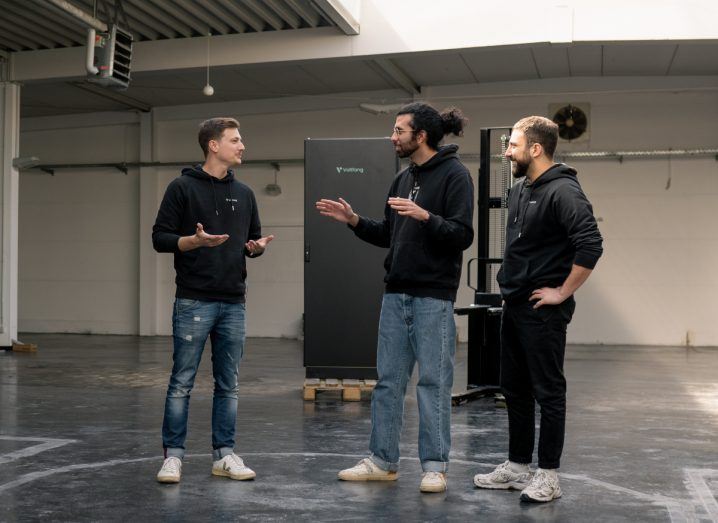
Based near their alma mater in Aachen, the founders of German start-up Voltfang have been making the most of the talent available to grow their innovative business.
Electric cars are all the rage now. With revenue expected to reach well over half a trillion in 2023, founders and investors have their eyes set on the EV industry as it grows at an annual rate of more than 10pc to replace traditional oil and gas-based vehicles.
But while EVs continue to make the world a little more sustainable than it used to be, what about sustainability within the industry? One of the challenges around using electric cars has been the question of what to do with the EV batteries once they are too old to be used.
Voltfang, a start-up based in Germany’s westernmost city of Aachen, has found an innovative and efficient alternative to recycling old batteries: repurposing them for energy storage.
Making energy storage more cost efficient
Founded in 2021 by college friends David Oudsandji, Roman Alberti and Afshin Doostdar, Voltfang has been getting the most out of old, high-performance EV batteries by requalifying them after their first life into power storage systems for commercial and industrial use.
“Commercial and industrial SME clients often struggle with enabling sustainable production and power supply,” says Oudsandji, an engineer by background who serves as the company’s CEO.
“With our storage systems, we can help making a PV [photovoltaic] system or other renewables more cost efficient and the customers more energy independent.”
While recycling is an option, it is usually considered a last resort when an object – especially electronic – cannot be reused or repurposed.
The idea for Voltfang arose when Oudsandji and his co-founders – all passionate about sustainable energy solutions – met while studying engineering at RWTH Aachen University, a public research university located in the city close to the French and Dutch borders.
“Our journey began when we bought a campervan and converted it to be energy-independent, sparking our interest in battery technology. We came across second-life battery modules, which led us to dive deeper into the field,” Oudsandji tells SiliconRepublic.com.
‘Optimal overview’ of energy flow
Today, that interested has culminated in advanced techniques that refurbish EV batteries that are no longer suitable for use in vehicles because of diminished capacity. However, they still retain a significant amount of energy storage potential.
“With the help of innovative testing based upon deep learning algorithms Voltfang can accurately forecast the lifetime of each battery module. So rather than disposing the batteries after their first life, clients can safely use them for up to 10 years,” Oudsandji explains.
Voltfang technology allows one to monitor each battery module while they are charging and draining energy to give a client an “an optimal overview” of their energy flow while also minimising complex installation procedures.
“This approach ensures that businesses can quickly deploy and benefit from energy storage without significant downtime. Because of the reuse of EV batteries, Voltfang doesn’t need to import any critical materials from outside the EU and can reduce delivery time.”
Clearly this approach has been working for Voltfang, which raised €5.2m in a seed round this summer. Being close to the founders’ alma mater, RWTH Aachen, has helped the start-up access the kind of wealth of engineering and business talent that it needs to scale.
Over the past year, Voltfang doubled its headcount from 30 to 60 and continues to grow. Now, the start-up has its eyes on yet another growth spurt with a planned funding round for September 2024.
“Deploying numbers has been one of the best performing indexes crushing all goals in the last months,” adds Oudsandji. Since Voltfang started at the beginning of this year, we have been deploying more than 800 kWh of energy storage systems.”